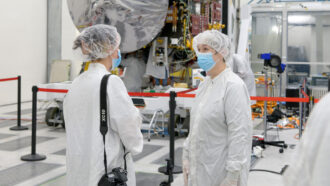
Becoming an astronomer might seem straightforward. An awe of the night sky sparks a child to someday study astronomy in school, eventually leading to a graduate degree and a job in the field. But as two new books make clear, few women find the road so simple.
In A Portrait of the Scientist as a Young Woman, Lindy Elkins-Tanton, a geologist turned planetary scientist, recounts her struggles with depression and anxiety as a child and with the sexism she faced early in her career. In one example, she and colleagues (all men but one) were collecting rock samples in Siberia, searching for evidence of a connection between volcanic eruptions and past extinction events. Taking her time to set her chisel at just the right spot to break the rock, Elkins-Tanton could “practically smell the silent impatience from the men nearby,” she writes. “Yes, they could have done it faster, and with fewer blows. But why should that be the important metric? Why is it not more important to let each person do the tasks they want and need to do, at their own pace?”
Her male colleagues’ implicit and explicit bias against women in science, she writes, fanned her own self-doubt. To demand the same respect as male scientists, she learned she had to insist, gently, to carry her own baggage and take her own samples, her way and on her time. The lessons she learned in Siberia and in the lab, she writes, helped her develop a compassionate and just leadership style as the director of Arizona State University’s School of Earth and Space Exploration and as the head of NASA’s upcoming Psyche mission. That mission will send a spacecraft to probe a metal-rich asteroid to better understand Earth’s iron-rich core.
Every scientist’s experience is unique, but elements of Elkins-Tanton’s story, particularly the sexism in science, find voice throughout The Sky Is for Everyone: Women Astronomers in Their Own Words. Edited by astronomer Virginia Trimble and author David Weintraub, this anthology of 37 short autobiographies covers more than six decades of astronomy and shows the varied paths of female astronomers and the roadblocks that can slow or sideline their success.
Astrophysicist France Córdova, for instance, opens her story with an evocative description of the time she spent in the summer of 1968 in a pueblo near Oaxaca City, Mexico, working on a cultural anthropology project. She had planned to study anthropology in graduate school, but after watching a TV show on dead stars, she realized she “had a deeper wanderlust inside,” she writes, “to connect with something wider, deeper than I could imagine — the stars and the Universe that held them.”
As a child, Córdova hadn’t known anyone who believed women could be scientists. Her parents thought finding a husband should be her college goal. Instead, she chose to pursue a graduate degree in astrophysics. She launched a career in X-ray astronomy and then pivoted again to policy and leadership, assuming the role of NASA’s chief scientist and later head of the National Science Foundation — positions where, she writes, she could advocate more effectively for women in science.
Dara Norman, in contrast, never questioned that she’d become an astronomer; by age 10 she was certain. She earned a Ph.D. in 1999 after studying bias in the measurements of distant galaxies that can distort our understanding of the universe. To her, the similarities between biases in scientific data and biases in the culture of science were blatant. “I am amazed that as scientists we understand the idea of bias in our data and methods…. We work tirelessly to identify such biases … and eliminate that bias,” she writes. “However, when confronted with bias in our profession … many of us continue to deny the existence of the issue.”
Norman realized the traditional path of an astronomer wasn’t for her. The joy of doing research was overshadowed by the negative experiences she endured “as a Black American woman just trying to be a scientist.” Like Córdova, she now works to improve the culture of science, at the National Optical-Infrared Astronomy Research Lab in Tucson.
That culture is changing, slowly. Before 1990, fewer than 40 women held full-time positions in astronomy or astrophysics at North American universities. Now, the number is high enough that it’s not as easy to track how many women successfully pursue a career in the field, Trimble and Weintraub note. Although those numbers point to progress, both books remind readers that blatant and subtle acts of sexism are still present and that careers in science can still be precarious for women. And yet women persist, perhaps, as Elkins-Tanton writes, driven by the “realization that we are only a tiny part of a vast unexplored universe.” If true, it’s a pillar of resilience to aspire to.
Buy A Portrait of the Scientist as a Young Woman and The Sky Is for Everyone from Bookshop.org. Science News is a Bookshop.org affiliate and will earn a commission on purchases made from links in this article.

 A new treatment could restore some mobility in people paralyzed by strokes
A new treatment could restore some mobility in people paralyzed by strokes  What has Perseverance found in two years on Mars?
What has Perseverance found in two years on Mars?  This robot automatically tucks its limbs to squeeze through spaces
This robot automatically tucks its limbs to squeeze through spaces  Greta Thunberg’s new book urges the world to take climate action now
Greta Thunberg’s new book urges the world to take climate action now  Glassy eyes may help young crustaceans hide from predators in plain sight
Glassy eyes may help young crustaceans hide from predators in plain sight  A chemical imbalance doesn’t explain depression. So what does?
A chemical imbalance doesn’t explain depression. So what does?